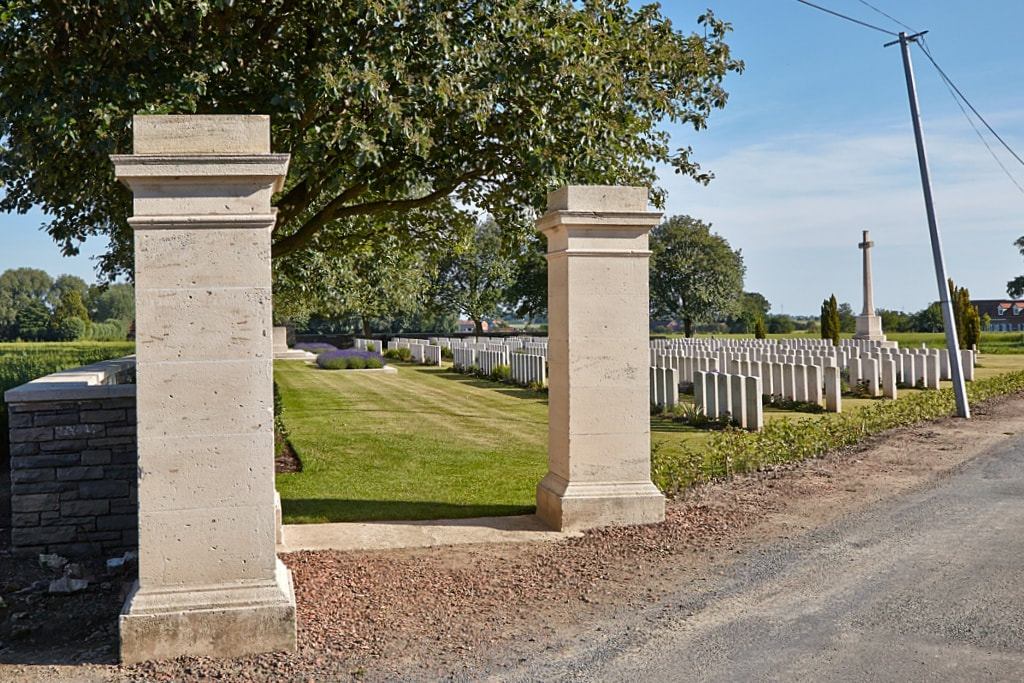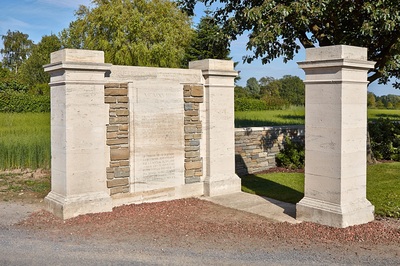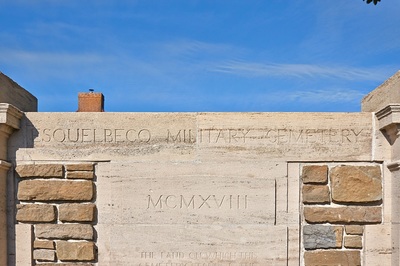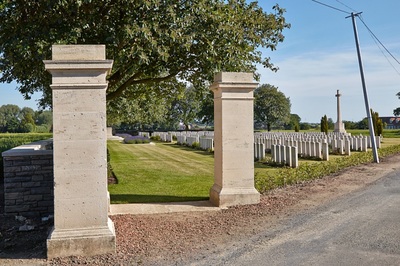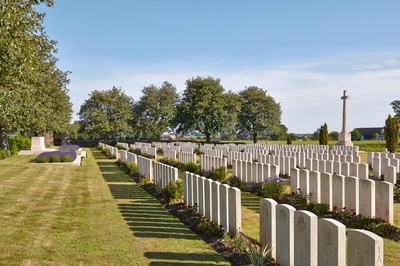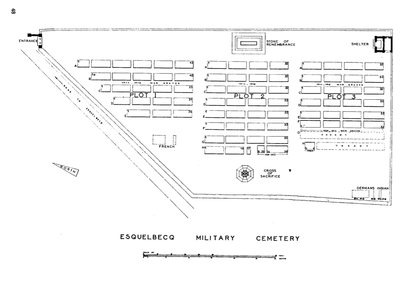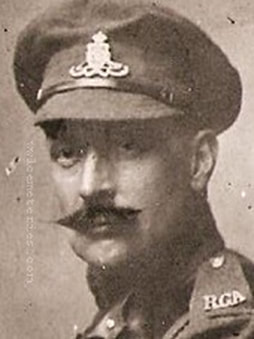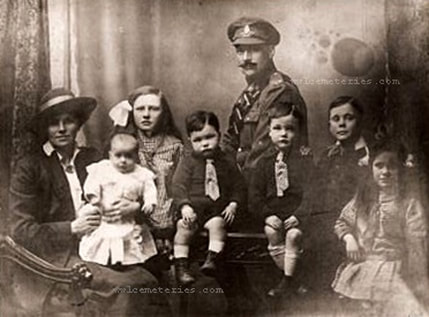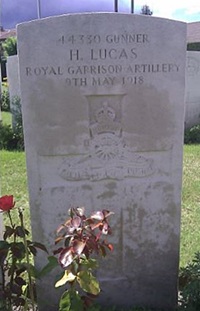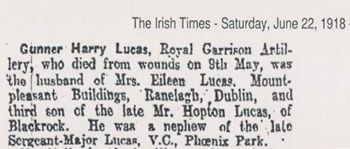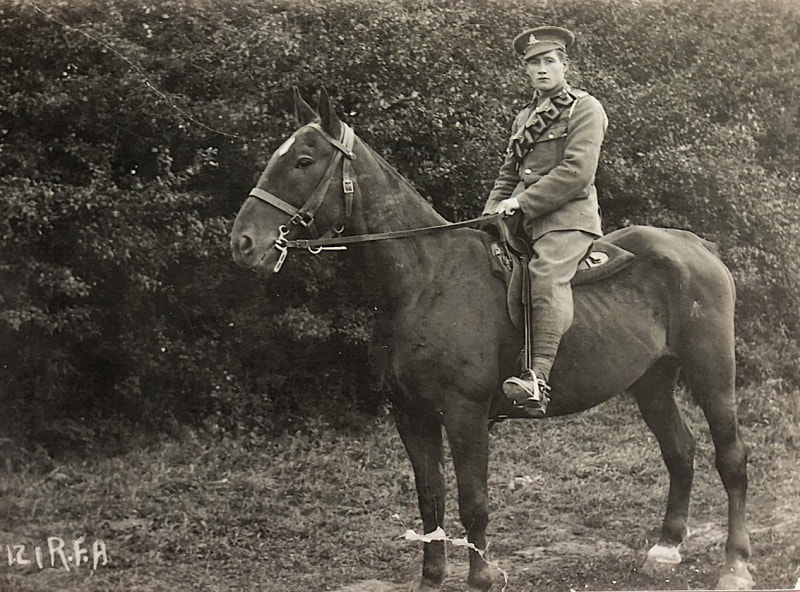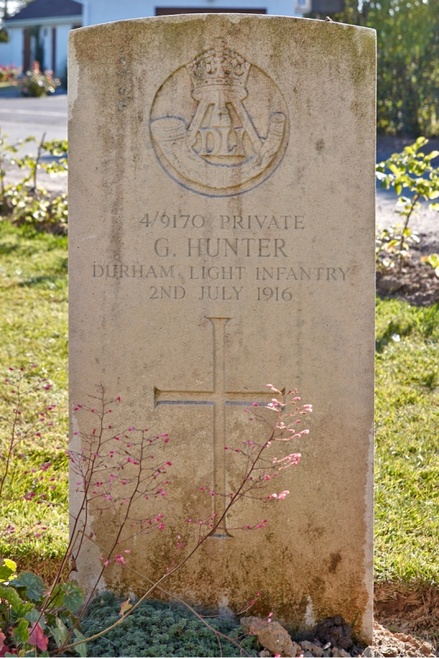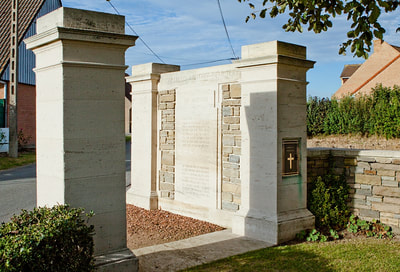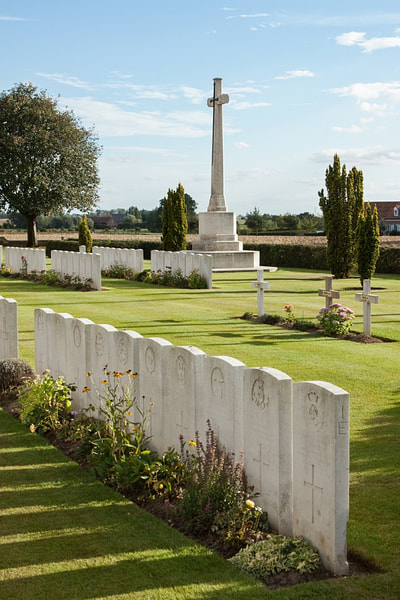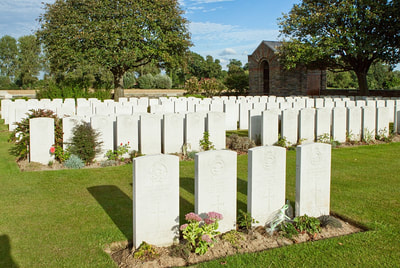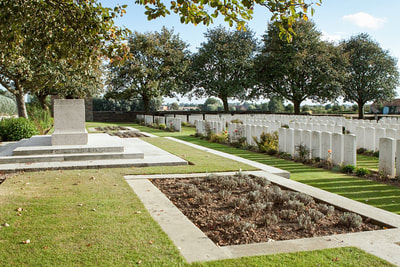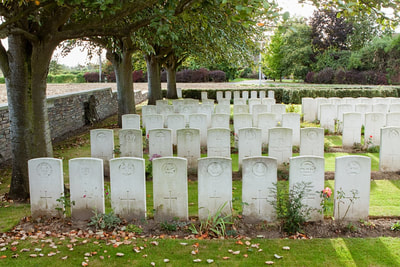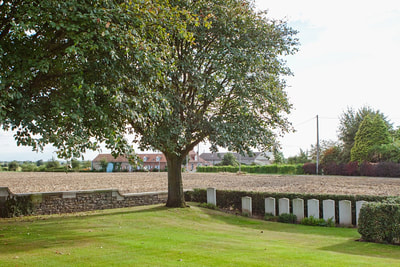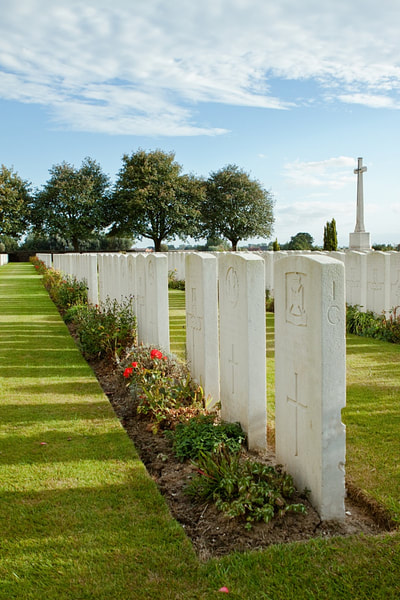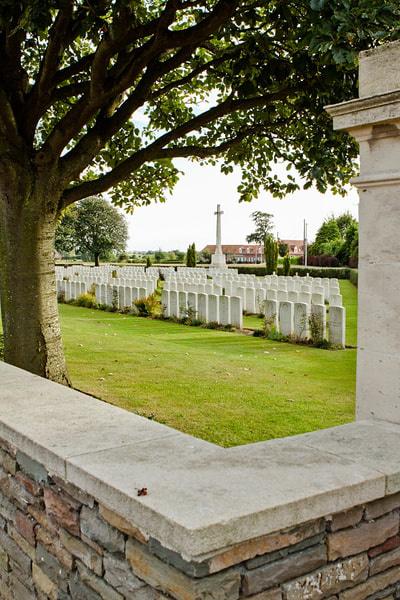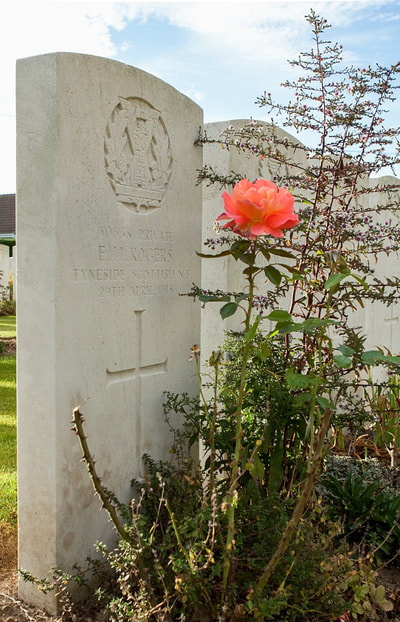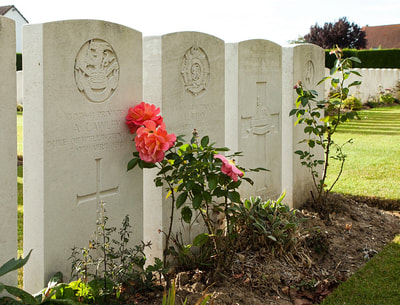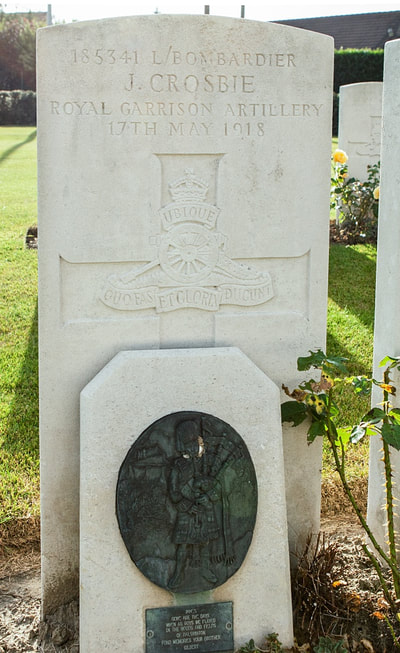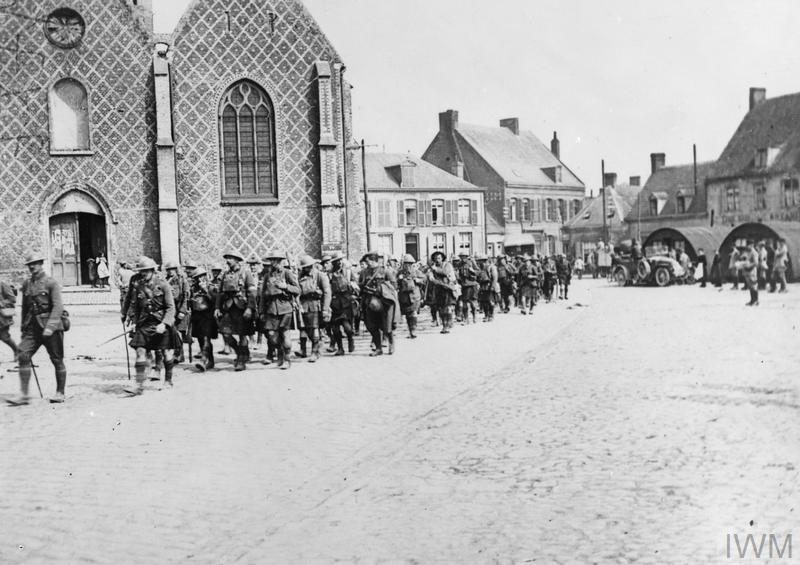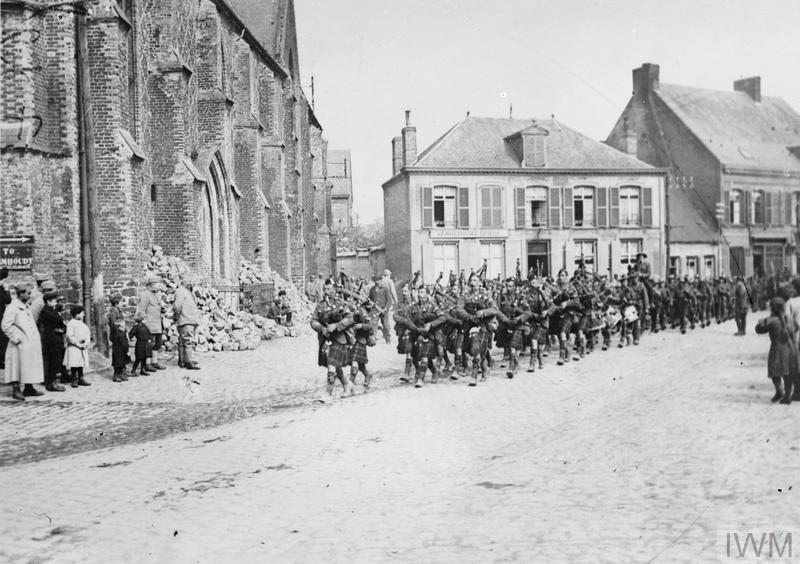ESQUELBECQ MILITARY CEMETERY
Nord
France
GPS Coordinates Latitude: 50.88713 Longitude: 2.41609
Location Information
Esquelbecq is a village near the Belgian frontier, 24 kilometres north of Hazebrouck and the same distance south of Dunkirk. The Military Cemetery is about one kilometre west of the village, 200 metres south of the road to Zeggers-Cappel.
Historical Information
The cemetery was opened in April 1918 during the early stages of the German offensive in Flanders, when the 2nd Canadian and 3rd Australian Casualty Clearing Stations came to Esquelbecq. It was closed in September 1918.
The cemetery was used again during the Second World War, mainly for the burial of those killed during the German advance of May 1940 and the withdrawal of the British Expeditionary Force to Dunkirk.
Esquelbecq Military Cemetery contains 578 Commonwealth burials of the First World War and 47 from the Second World War. There are also 11 French and German burials.
Commemorated here are 30 of the victims of the Wormhoudt massacre that occurred on 28 May 1940 during the evacuation from Dunkirk.
On previous days, the First Battalion of the Leibstandarte SS Adolf Hitler (formed in 1933 as Hitler’s personal bodyguard) had suffered a heavy defeat at the hands of the Royal Warwicks, the Royal Cheshires & the Royal Artillery; & moreover SS General Sepp Dietrich (C-in-C of the Sixth SS Panzer Army) had twice been attacked when being driven around the area in his car, wounded the second time, & — at some cost to the SS — rescued.
Orders were given to the Second Battalion (under Hauptsturmführer Wilhelm Mohnke) to attack the British HQ at Wormhoudt. When this was overrun, & ammunition exhausted, surrender was inevitable. The remaining British troops (almost 100) were rounded up, & in due course marshalled into an empty barn. Hand-grenades were then thrown in, but when the SS realised that 2 British NCOs (Sgt Stanley Moore & CSM Augustus Jennings) had thrown themselves on top of the grenades to shield others, forced out some of the troops to be shot, & sprayed gunfire on those remaining inside. The SS abandoned the scene, believing that there would be no survivors. 80 had died that day, a further 9 soon thereafter from their wounds, 6 survived, some of whom were able in due course to testify to the events.
Charge was taken of the scene 2 days later by German army medics (or a unit of the German Red Cross) who had been looking for wounded SS troops; & the dead soldiers were buried in a shallow grave nearby by the French. Investigation began in early 1944 soon after the news reached Britain, but despite extensive inquiries, it did not prove possible to bring Mohnke to book for his crime.
See Also La Plaine-au-Bois Memorial.
Total Burials: 636.
World War One identified Casualties: United Kingdom 569, Germany 7, New Zealand 4, France 4, Australia 2, Canada 1, India 1, South Africa 1. Total 589.
World War Two Identified Casualties: United Kingdom 40, Canada 1. Total 41.
World War Two Unidentified Casualties: 6. Total 6.
The cemetery was designed by Sir Edwin Lutyens and Arthur James Scott Hutton
Dedications
Second Lieutenant Frederick William Canty, 3rd Bn. East Yorkshire Regiment, attd. 2nd Bn. York and Lancaster Regiment 29th June 1918, aged 23.
Remembered with love by granddaughter Susan and family
Esquelbecq is a village near the Belgian frontier, 24 kilometres north of Hazebrouck and the same distance south of Dunkirk. The Military Cemetery is about one kilometre west of the village, 200 metres south of the road to Zeggers-Cappel.
Historical Information
The cemetery was opened in April 1918 during the early stages of the German offensive in Flanders, when the 2nd Canadian and 3rd Australian Casualty Clearing Stations came to Esquelbecq. It was closed in September 1918.
The cemetery was used again during the Second World War, mainly for the burial of those killed during the German advance of May 1940 and the withdrawal of the British Expeditionary Force to Dunkirk.
Esquelbecq Military Cemetery contains 578 Commonwealth burials of the First World War and 47 from the Second World War. There are also 11 French and German burials.
Commemorated here are 30 of the victims of the Wormhoudt massacre that occurred on 28 May 1940 during the evacuation from Dunkirk.
On previous days, the First Battalion of the Leibstandarte SS Adolf Hitler (formed in 1933 as Hitler’s personal bodyguard) had suffered a heavy defeat at the hands of the Royal Warwicks, the Royal Cheshires & the Royal Artillery; & moreover SS General Sepp Dietrich (C-in-C of the Sixth SS Panzer Army) had twice been attacked when being driven around the area in his car, wounded the second time, & — at some cost to the SS — rescued.
Orders were given to the Second Battalion (under Hauptsturmführer Wilhelm Mohnke) to attack the British HQ at Wormhoudt. When this was overrun, & ammunition exhausted, surrender was inevitable. The remaining British troops (almost 100) were rounded up, & in due course marshalled into an empty barn. Hand-grenades were then thrown in, but when the SS realised that 2 British NCOs (Sgt Stanley Moore & CSM Augustus Jennings) had thrown themselves on top of the grenades to shield others, forced out some of the troops to be shot, & sprayed gunfire on those remaining inside. The SS abandoned the scene, believing that there would be no survivors. 80 had died that day, a further 9 soon thereafter from their wounds, 6 survived, some of whom were able in due course to testify to the events.
Charge was taken of the scene 2 days later by German army medics (or a unit of the German Red Cross) who had been looking for wounded SS troops; & the dead soldiers were buried in a shallow grave nearby by the French. Investigation began in early 1944 soon after the news reached Britain, but despite extensive inquiries, it did not prove possible to bring Mohnke to book for his crime.
See Also La Plaine-au-Bois Memorial.
Total Burials: 636.
World War One identified Casualties: United Kingdom 569, Germany 7, New Zealand 4, France 4, Australia 2, Canada 1, India 1, South Africa 1. Total 589.
World War Two Identified Casualties: United Kingdom 40, Canada 1. Total 41.
World War Two Unidentified Casualties: 6. Total 6.
The cemetery was designed by Sir Edwin Lutyens and Arthur James Scott Hutton
Dedications
Second Lieutenant Frederick William Canty, 3rd Bn. East Yorkshire Regiment, attd. 2nd Bn. York and Lancaster Regiment 29th June 1918, aged 23.
Remembered with love by granddaughter Susan and family
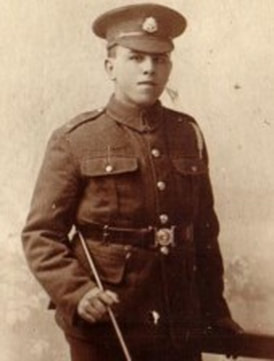
245354 Private
Thomas Wilkinson Grey
2nd Bn. Durham Light Infantry. Formerly 226024 East Yorkshire Regiment
30th May 1918, aged 22.
Plot I. E. 18.
Son of Thomas Wilkinson Grey and Charlottie Grey, of 52, Ann St., Plumstead, London.
Picture courtesy of Robert Grey
Thomas Wilkinson Grey
2nd Bn. Durham Light Infantry. Formerly 226024 East Yorkshire Regiment
30th May 1918, aged 22.
Plot I. E. 18.
Son of Thomas Wilkinson Grey and Charlottie Grey, of 52, Ann St., Plumstead, London.
Picture courtesy of Robert Grey
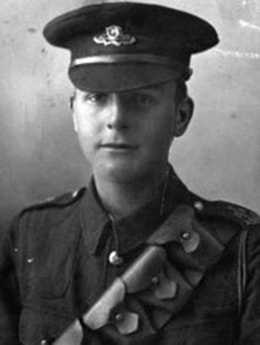
781755 Gunner
Robert Douglas Law
"C" Bty. 246th Bde. Royal Field Artillery
21st May 1918, aged 21.
Plot II. D. 6.
Son of Booth and Jessie Law, of 21, Darfield St., Bradford.
Robert Douglas Law
"C" Bty. 246th Bde. Royal Field Artillery
21st May 1918, aged 21.
Plot II. D. 6.
Son of Booth and Jessie Law, of 21, Darfield St., Bradford.
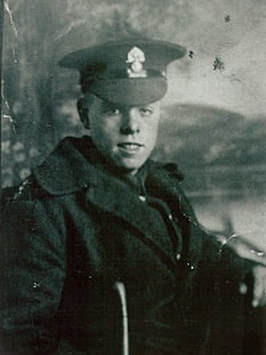
G/81565 Private
W. T. Moon
26th Bn. Royal Fusiliers
2nd May 1918, aged 19.
Plot II. B. 27.
Son of Thomas and Ellen Moon, of 82, Priory St., Liverpool.
INSCRIPTION : GOD IS LOVE THY WILL BE DONE
Picture courtesy of Ian Moon
W. T. Moon
26th Bn. Royal Fusiliers
2nd May 1918, aged 19.
Plot II. B. 27.
Son of Thomas and Ellen Moon, of 82, Priory St., Liverpool.
INSCRIPTION : GOD IS LOVE THY WILL BE DONE
Picture courtesy of Ian Moon
1048 Bombardier
John William Peacey
"B" Battery, 121st Brigade, Royal Field Artillerydied
30th April 1918, aged 28.
Plot I. B. 33.
Brother of Mrs. M. J. Collins, of 69, The Crescent, Bedwas, Cardiff. Native of Tredegar, Mon.
Son of George and Mary Jane Peacey, Monmouthshire UK. Born September 1890
His headstone bears the inscription
"HE GAVE HIS LIFE FOR ALL"
Picture courtesy of Carolyn Hide (granddaughter)
John William Peacey
"B" Battery, 121st Brigade, Royal Field Artillerydied
30th April 1918, aged 28.
Plot I. B. 33.
Brother of Mrs. M. J. Collins, of 69, The Crescent, Bedwas, Cardiff. Native of Tredegar, Mon.
Son of George and Mary Jane Peacey, Monmouthshire UK. Born September 1890
His headstone bears the inscription
"HE GAVE HIS LIFE FOR ALL"
Picture courtesy of Carolyn Hide (granddaughter)
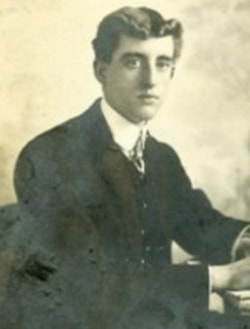
31387 Private
William Francis Pickering
2nd Bn. South Lancashire Regiment
30th April 1918, aged 23.
Plot. I. B. 28.
Son of Mrs. A. Pickering, of 31, Bloomsgrove Rd., Ilkeston, Derbyshire.
Picture courtesy of Dr. Colin Pounder
William Francis Pickering
2nd Bn. South Lancashire Regiment
30th April 1918, aged 23.
Plot. I. B. 28.
Son of Mrs. A. Pickering, of 31, Bloomsgrove Rd., Ilkeston, Derbyshire.
Picture courtesy of Dr. Colin Pounder

7308 Private
John Pritchard
1st Bn. King's Shropshire Light Infantry
1st July 1918, aged 38.
Plot III. A. 27.
Son of Edward and Mary Pritchard, of Oswestry; husband of Mary E. Pritchard, of 19, Middleton Rd., Oswestry.
John Pritchard pictured with his wife Mary
Picture courtesy of Philip Allmark, grandson
John Pritchard
1st Bn. King's Shropshire Light Infantry
1st July 1918, aged 38.
Plot III. A. 27.
Son of Edward and Mary Pritchard, of Oswestry; husband of Mary E. Pritchard, of 19, Middleton Rd., Oswestry.
John Pritchard pictured with his wife Mary
Picture courtesy of Philip Allmark, grandson
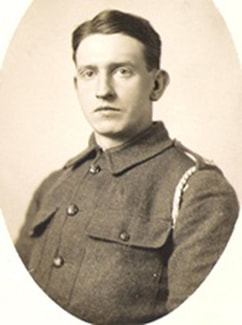
M2/046874 Private
Percy William Paul Turner
Army Service Corps. attd. 16th Siege Bde. Ammunition Column. Royal Garrison Artillery
3rd July 1918, aged 27.
Plot III. C. 1.
Son of Esther Catherine Turner, of 65, Harlescott Rd., Nunhead, London, and the late Edward Frederick Charles Turner. Percy is also commemorated on the memorials at Borough Polytechnic Institute and Southwark & St. Silas, Nunhead
Picture courtesy of Great nephew, Charles Turner
Percy William Paul Turner
Army Service Corps. attd. 16th Siege Bde. Ammunition Column. Royal Garrison Artillery
3rd July 1918, aged 27.
Plot III. C. 1.
Son of Esther Catherine Turner, of 65, Harlescott Rd., Nunhead, London, and the late Edward Frederick Charles Turner. Percy is also commemorated on the memorials at Borough Polytechnic Institute and Southwark & St. Silas, Nunhead
Picture courtesy of Great nephew, Charles Turner
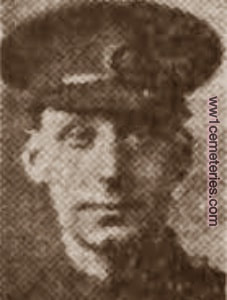
49537 Lance Corporal
Frederick Willson
1st Bn. Royal Inniskilling Fusiliers
3rd June 1918, aged 29.
Plot II. E. 13.
Son of William Uffendale Willson and Margaret Willson, of Salford, Manchester; husband of Mary Jane Willson, of 29, Eaves Knoll, New Mills, Stockport.
His headstone bears the inscription: "Thy Will be Done."
Frederick Willson
1st Bn. Royal Inniskilling Fusiliers
3rd June 1918, aged 29.
Plot II. E. 13.
Son of William Uffendale Willson and Margaret Willson, of Salford, Manchester; husband of Mary Jane Willson, of 29, Eaves Knoll, New Mills, Stockport.
His headstone bears the inscription: "Thy Will be Done."
Shot at Dawn
Private George Hunter, 2nd Bn. Durham Light Infantry, executed for desertion on 2nd July 1916, Plot I. B. 1A. Having absented himself previously on 10 different occasions,& also having been convicted of carelessly wounding himself, he deserted from the trenches at the north of Ypres during May 1916. Hunter was the first of the very few soldiers who managed to cross the Channel to England — where he was arrested. At trial, he claimed to have suffered from ‘a wandering mind’ for 18 months; & after trial his commanding officer recommended examination for mental abnormality, but no notice was taken. (Putkowski, p.92)
Private George Hunter, 2nd Bn. Durham Light Infantry, executed for desertion on 2nd July 1916, Plot I. B. 1A. Having absented himself previously on 10 different occasions,& also having been convicted of carelessly wounding himself, he deserted from the trenches at the north of Ypres during May 1916. Hunter was the first of the very few soldiers who managed to cross the Channel to England — where he was arrested. At trial, he claimed to have suffered from ‘a wandering mind’ for 18 months; & after trial his commanding officer recommended examination for mental abnormality, but no notice was taken. (Putkowski, p.92)

